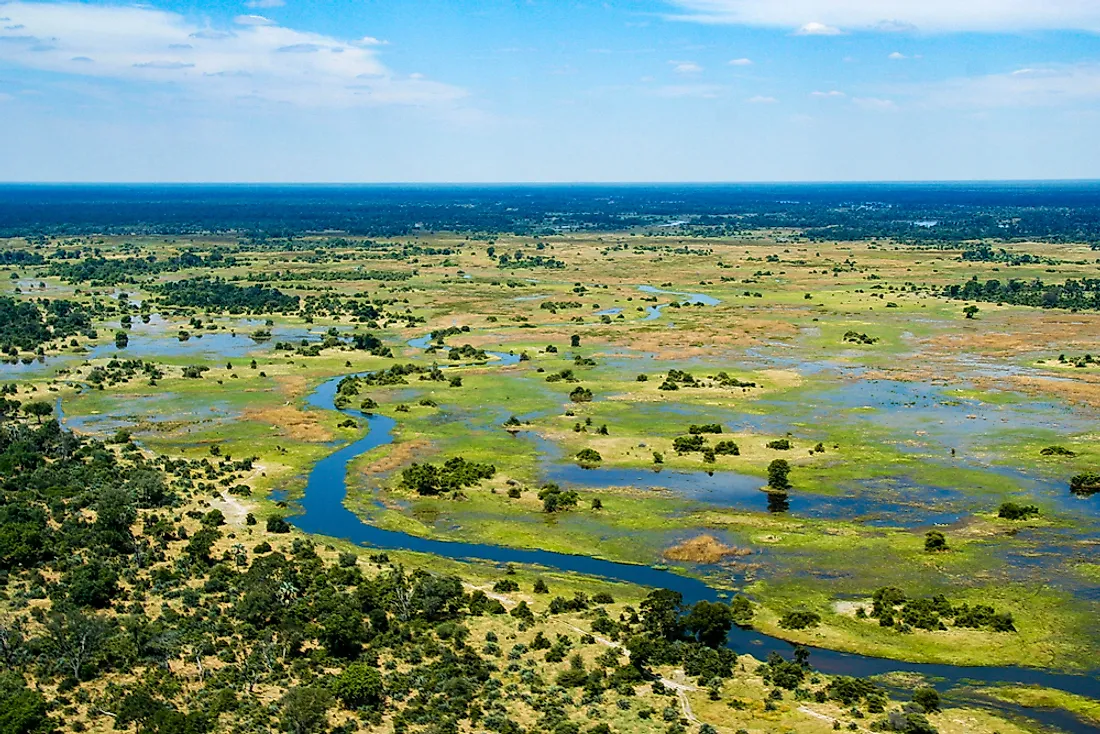How Many Types Of Deltas Are There?

A delta is formed at a river’s mouth where the river deposits the sediments carried by it and branches out into distributaries that flow into the sea or lake or another water body. Very rarely, rivers do not drain into any other water body but simply empty onto a plain. Deltas can be classified on the basis of two major factors: (1) the major processes or influencing factors that determine the shape and size of the delta and (2) the shape of the delta.
Types of Deltas Based on the Influencing Factor
1. Wave-dominated Deltas
In wave-dominated deltas, the action of waves determines the size and shape of the delta. Such deltas usually have fewer distributary channels. Waves influence the formation of a delta by affecting the sediment depositional patterns near the mouth of a river. It disperses the sediments from the mouth along the shores so that it does not accumulate as a bar at the mouth of the river. Thus, there are no impediments to the movement of the river and hence there are fewer distributaries in such deltas. The waves also sort the sediments at the river mouth. The fine-grained sediments are washed away offshore while the coarser sediments remain behind. The delta of the Nile River along the Mediterranean Sea is an example of a wave-dominated delta.
2. Tide-dominated Deltas
The rise and fall of tides shape the tide-dominated deltas. Such deltas are common in areas with a large tidal range. They usually have a large number of distributaries. Prominent sandbars and ridges exist in such deltas which lead to the formation of a dendritic structure of the delta. As one distributary silts up due to tidal action, it branches out to form two or more distributaries. The Ganges-Brahmaputra delta in India and Bangladesh is an example of a tide-dominated delta.
3. Gilbert Deltas
A Gilbert delta is another type of delta that is formed by the deposition of coarse sediments at the mouth of a river. Grove Karl Gilbert, a geologist, was the first person to describe this type of delta. According to some, Gilbert deltas can have both marine and lacustrine locations, according to others, such deltas only occur at places where a river empties into a freshwater lake by depositing its coarse sediments at the mouth. Mountain rivers carrying coarser sediments at the upper course and emptying into a freshwater lake can form ideal Gilbert deltas.
4. Estuarine Deltas
When a river does not directly empty into the sea but forms an estuary at its mouth, it is called an estuarine delta. An estuary is a brackish water body that is partially enclosed. Located in the transition zone between the river and the sea, and subjected to both marine and riverine influences, an estuary is one of the most productive natural habitats in the world. Some examples of rivers forming estuaries are the Yellow River of China and the estuary of the Tagus River in Portugal.
Types of Deltas Based on Shape
1. Arcuate Deltas
The term delta is derived from the upper-case Greek letter delta since a delta is expected to have a typical delta or triangular shape. However, not all deltas have this shape. Those that do are called arcuate deltas or arc-like deltas or fan-shaped deltas. The Nile delta is an example of an arcuate delta.
2. Cuspate Deltas
A cuspate delta is formed in regions with stronger waves. It is quite similar to an arcuate delta in shape but is more pointed towards the sea. The delta formed by the Tiber River at its mouth on the Tyrrhenian Sea near Rome is an example of such a delta.
3. Bird-foot Deltas
Such a delta is not exactly triangular-shaped but appears like a bird’s foot when viewed from above. Here, the distributaries are more widely spaced than in the above two mentioned types of deltas. An example is the delta of the Mississippi River as it drains into the Gulf of Mexico.
4. Inverted Deltas
The inverted delta is another type of delta based on the shape of deltas. As the name suggests, an inverted delta’s distributary network faces inland while a single stream leads to the sea. An example of such a delta is the one formed by the Sacramento-San Joaquin River in northern California.
Other Types of Deltas
Inland Deltas
An inland delta is rare. It refers to a delta that empties into a plain. The Okavango Delta in Botswana is a classic example of this type of delta. The Okavango River does not empty into the sea or lake or any other water body. It simply spreads its water along a flat plain in the Kalahari Desert. The evaporation process prevents the water from accumulating in the plain.
Abandoned Deltas
An abandoned delta is the dry delta bed left behind after a river discards its former channel and enters or develops a new one. Such a situation often arises when the original channel is highly silted so that the river does not find a proper slope to flow through. Hence, it overflows its banks and finds a steeper and more direct route to the sea or lake into which it drains. The process of a river leaving a delta is called avulsion. The delta left behind thus dries up. The Mississippi River has several abandoned deltas that were formed over a period of over 5,000 years.











